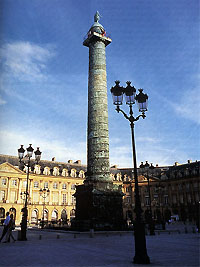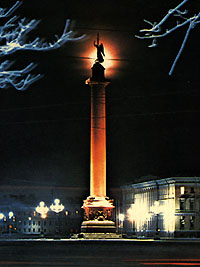|
| TRIUMPHAL PILLARS OF PARIS AND SAINT PETERSBURG |
|
Pillar of Vandom
(Paris) 
Being elected first consul, Napoleon Bonaparte decided to build the pillar to perpetuate the memory of his Italian victories and to render homage to the courage of his soldiers. Napoleon abandonned the initial idea to bring from Rome to Paris the famous pillar of Trajan and in July 1800 he choose Vandom square [1] as the place of construction. Vandom square is situated on the right bank of Seine river. But the final decision was is taken only 1 October 1803, but decree-law about its building appeared only 1 January 1806. Exactly at that time the construction began. At first, it was named the Pillar of Austerlitz then Pillar of Victories or "Pillar of Great Army". The official leader of the construction was Denon [2] but really the other two architects Gondouin [3] and Lepere made a project work. The construction of the pillar was completed (finished) in august 1810. The height of pillar is 44 metres, width (in base) - 3,67 m. Inside the pillar (poured from bronze of 1250 cannons (guns), praised in battle of Austerlitz) you can find 176 stairs leading up to platform. There is a statue of Napoleon in the cloths of roman Emperor (by sculptor Chodet). The pillar is twine around by bronze spiral bas-relief with the battle scenes. The further history of pillar is both dramatic and amazing. During the Restoration the Napoleonic statue was melted, and king's Georges IV [4] statue crowned the pillar. At the period of "100 days" the statue of king was removed. During rule of king Louis-Phillip the statue of Napoleon was newly installed but that time vested (robed) in uniform dress coat of the officer of revolutionary army. In 1871, in the time of Paris Commune, pillar was completely destroyed. The demolition was managed by the artist Courbet [5]. He headed the Art commission of Commune. In 1875, under the third republic, on (by) the initiative and at the expense of Courbet, the pillar was restored on the same place. Since that time and till today you can see there a copy of initial statue of Napoleon as (in image of) roman Emperor. Notes: 1 Vandom square is one of the main squares of Paris. It's famous as architectural ensemble of epoch of classicism. Originally was called the square of Conquests. Later, it was called by name of residence owner - duke Vandom (he was a natural son of king George IV). It was built by the project of architect Arduaine (1646-1708). Originally in the center of the square there was the equestrian statue of king Louis XIV by the sculptor Giradout (1628-1715), ruined by people (citizens) of Paris at day of dethronement of monarchy in august 10, 1792. 2 Denon Dominique Vivian, baron (Chalon-sur-Saon, January 4, 1747, - Paris, April 27, 1825.). 3 Gondouin Jacque (Saint Ouent, June 7, 1737 - Paris, December 29, 1818). 4 Georges IV Bourbon (1553-1610) - first king of France from Bourbon dynasty. 5 Courbet Guistave (1819-1877). |
Pillar of Alexander
(Saint Petersburg) 
Pillar of Alexander I has been constructed in 1834 in the center Palace (Dvortsovaya) square [1] in Saint Petersburg by architect August Richard Monferran [2] according the order of Emperor Nicolas to immortalize his elder's brother victory - Emperor Alexander I - over Napoleon. The initial project of Monferran - to built the granite obelisk - was declined by Nicolas I, and, as a result, Monferran create a monument which represent a huge pillar from rose granite, placed on the square pedestal. The pillar is crowned by the sculpture of Orlovski [3], representing the gilded angel with face of Emperor Alexander I. There is a cross in the left hand of the angel and his right hand is lifted (up) to heaven. The total height of the pillar (with statue) is 47,5 m. It's the highest of all similar monuments of the world: Pillar of Vandom in Paris, Pillar of Trajan in Rome and Pillar of Pompea in Alexandria). The diameter of this pillar is 3,66 m. The four sides of the pillar's pedestal are decorated by bronze bas-reliefs with ornaments of the soldiers armours, as well as allegorical scenes of victories of russian weapon. The separate bas-reliefs represent the chain mails (chain armours) of ancient russains, spiked helmets, shields, kept in the Armour (Gun) chamber in Moscow Kremlin, as well as helmets of russain heros Alexander Nevsky and Ermak. The granite monolith, served (as) the base of the pillar, was mined from one of the quarries of Vyborg and transported in 1832 on specially constructed barge to Saint Petersburg for further processing (treatment). To install the pillar in vertical position there were attracted the power of 2000 soldiers and 400 workers. 1250 pine piles were rammed in (under) socle of pillar. The Pillar of Alexander is a miracle of engineering calculation (idea) - there is already more than 150 years it stands in vertical position fixed by nothing - only by the gravity of own weight, which is 600 tons. First years after its contraction, the citizens of Saint Petersburg were afraid that it would fall.Trying to persuade them Monferran formed a habit to walk around the pillar every day. And he has done this till his death. The best view of the pillar is through the arch of General Staff building (street Gertsin) and from the quay of river Moika. Notes: 1 Palace square is the main square of Saint Petersburg. The Main buildings are: Winter palace (1754-1762, by architect Rastrelli ), building of General Staff (1819-1829, by architect Rossi), former building of the Guard's staff corps (1837-1843, by architect Brulov). 2 Monferran (1786-1858). He lived and work in Russia since 1816, where he was baptized (has taken the name of) August. He has immortalized his name by construction of the Pillar of Alexander and the Isaac Cathedral (1818-1858) in Saint Petersburg. 3 Īrlovski (his real name is Smirnov) Boris (1796-1837) was a famous russian sculptor. He was the author of the monuments to Kutusov and to Barclay de Tolly (1828-1836), placed in Saint-Petersburg before the Kazan Cathedral. |